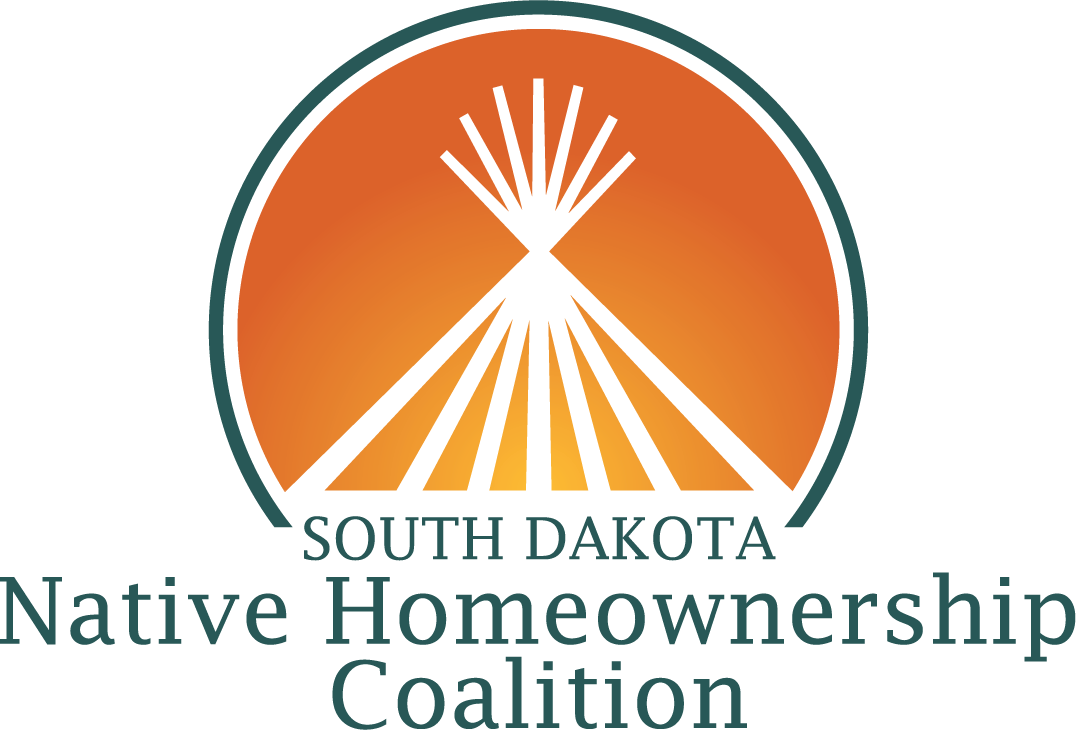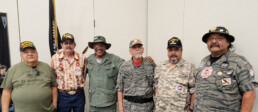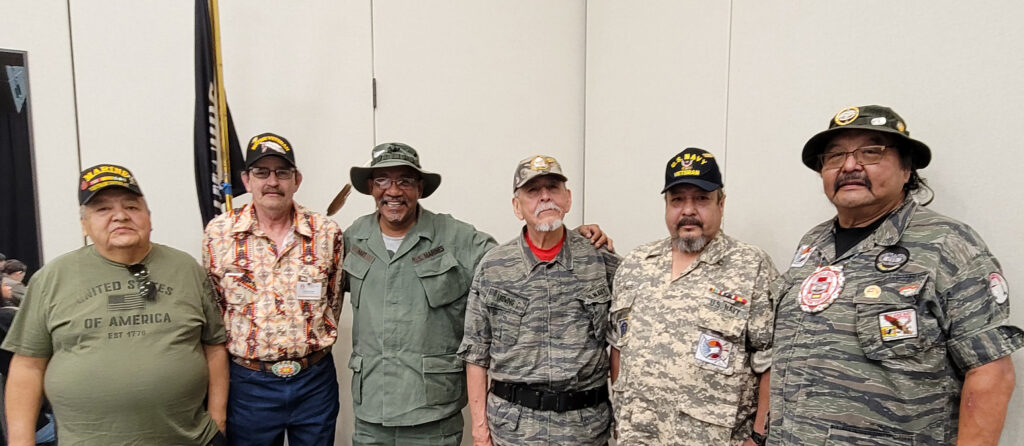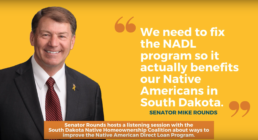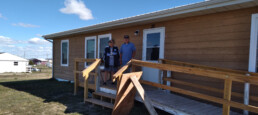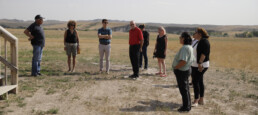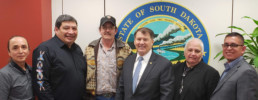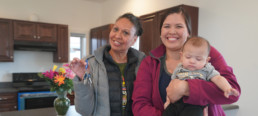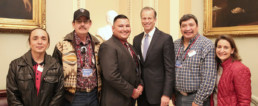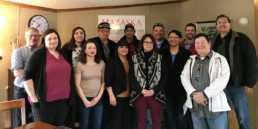Coalition Launches Native American Veterans Homeownership Needs Assessment
We are excited to announce that the Coalition has partnered with Big Water Consulting and NeighborWorks to launch a statewide study to better understand the current housing conditions and needs of Native American veterans living on South Dakota’s nine Indian reservations.
“The findings of this study will support the Coalition as we continue to increase access to homeownership resources for Native American veterans. It will also paint an accurate picture in our national policy discussions, ensuring federal programming aligns with the true needs of Native veterans,” says Cheryce Not Afraid, Director of the Coalition.
The first wave of the study begins today with surveys on the Cheyenne River, Crow Creek, Pine Ridge, and Rosebud Reservations. Second and third waves will begin in December and next spring, respectively, and will cover the remaining reservations throughout the state. The survey will capture general demographic information as well as more specific information regarding the respondent’s current housing situation, housing preferences, and housing challenges.
“We are putting out a call to all Cheyenne River, Crow Creek, Oglala, and Rosebud veterans to get in touch with us and answer the survey now. We’re also asking Flandreau, Lower Brule, Sisseton, Standing Rock, and Yankton vets to remain on stand-by, as their information will be critical in the coming months,” says Kimberly Long Soldier, the Coalition’s Homeownership Program Manager.
An online version of the survey can be accessed here. Veterans who wish to complete a paper survey can get in touch with a representative from their area.
Cheyenne River
Robert Dunsmore
(605) 200-9012
Michelle Running Wolf
(605) 964-4265
Crow Creek
Kay Koster
(605) 245-2059
Joe Shields
(605) 245-2250
Pine Ridge
Kimberly Long Soldier
(605) 455-2500
Rosebud
Monica Hunger Moran
(605) 747-2203
Orlando Morrison
(605) 747-2593
Senator Mike Rounds (R-SD) Hosts Listening Session on VA Native American Direct Home Loan Reform
Senator Mike Rounds (R-SD) and the South Dakota Native Homeownership Coalition held a listening session recently as part of the Senator’s efforts to reform the U.S. Department of Veterans Affairs (VA) Native American Direct Loan (NADL) program. In addition to participation from Senator Rounds, his staff, and Coalition members, the listening session featured testimonies about the NADL home loan process from several Native American veterans.
During the session, Senator Rounds told participants, “We need to fix the NADL program so it actually benefits our Native Americans in South Dakota.”
“Native veterans shouldn’t have to go to battle to get an NADL mortgage,” said Geri Opsal, Co-Chair of the Coalition’s Veteran’s Homeownership Committee and Tribal Veterans Service Officer for the Sisseton Wahpeton Oyate. “They should have the same access to their VA benefit as any other veteran applying for a VA guarantee loan off the reservation.”
“We really appreciate Senators Rounds’ leadership on this issue,” said Tawney Brunsch, Executive Director of Lakota Funds. “During our discussions, you could tell he really understood how important it is for Native veterans to have ‘boots on the ground’ to help them through the mortgage lending process.”
With an average of only 20 NADL applications being approved nationwide each year, Senator Rounds has engaged the Senate Veterans’ Affairs Committee to explore solutions that would provide Native American veterans with meaningful access to the benefits they have earned. Those efforts included a request to the Government Accountability Office to conduct a thorough review of the NADL program, which will be a crucial step toward systemic change.
A Veterans Day Celebration: Native American Veteran Becomes Lakota Federal Credit Union’s First Mortgage Client
With homeownership rates hitting a 12-year high despite the COVID-19 pandemic, Norman Rogers, a U.S. Navy veteran, is celebrating this major milestone alongside many others across the nation. Rogers is the first to close a mortgage loan from the Lakota Federal Credit Union, the only federally insured depository institution on the Pine Ridge Reservation – and also a Coalition member organization.
“The housing shortage is something that impacts so many people here on the Reservation. We believe that homeownership is a viable solution, and we are excited to officially launch our mortgage product to support more families in achieving their homeownership dreams,” said Shayna Ferguson, Branch Manager of the Lakota Federal Credit Union.
Rogers and his wife Eunice care for their 16-year-old grandson, and that was the primary motivating factor in pursuing homeownership after renting for 55 years.
“Paying rent for all those years, we could have owned three houses by now,” says Rogers. Even so, he is satisfied knowing that he is providing his family with a safe place to call home, even beyond his lifetime.
Many first-time homeowners on the Reservation are building assets that will be passed onto future generations, a strategy Tawney Brunsch, Board Chair of the Lakota Federal Credit Union and Executive Director of Lakota Funds, says is critical to breaking the cycle of poverty.
“Our approach to mortgage lending entails more than the immediate need of safe and affordable housing. We are also working on a longer-term strategy that will position our children and grandchildren to be better off financially,” says Brunsch.
Ferguson and Brunsch regularly collaborate to leverage each other’s programs and provide a more impactful experience for their clients. Rogers’ homeownership journey was no exception. Through their partnership and networks, Rogers was able to tap into over $20,000 in subsidies to improve the home’s energy efficiency and offset his mortgage. By working with Lakota Funds, Rogers completed a homebuyer education course and participated in matched savings programs to multiply his down payment. The Housing Assistance Council’s Affordable Housing for Rural Veterans initiative, which is supported by the Home Depot Foundation, provided funding for a new roof, windows, and doors on Rogers’ home, which have reduced his utility costs.
“The great thing about this is that Norman immediately had a substantial amount of equity built into his home,” says Brunsch. “For people on a fixed income, like many of our Reservation families, this provides more flexibility and options in how they handle financial emergencies, should they ever come up in the future.”
As Rogers reflects on his major life events – military service, a successful career in education, establishing schools, obtaining accreditation for Oglala Lakota College, sitting on several school boards – he comes back to a moment in 1956 when he was only one of seven Native American students to graduate Rapid City High School.
“I realized I had a lot more opportunity because I lived in Rapid City. Reservations do not have the same opportunities surrounding work and school as off reservation communities. I saw that back then and I thought, ‘I can make a difference.’ I enjoyed working with kids. Our schools had really low education levels and I fought for something better. I wanted to serve the community and the kids in the community,” he says.
More than a half century later, Rogers is still serving the community. He is paving the road to homeownership for others to follow.
“People like Norman are examples for what is truly possible. He may not know it, but he is inspiring his family members, neighbors, and even our community leaders to achieve more,” says Ferguson, “I can’t think of a better way to celebrate this year’s Veteran’s Day.”
Coalition Members Showcase Successful Native Veterans Homeownership Models
South Dakota Native Homeownership Coalition members are continuing to advocate for policies that increase rates of Native American veteran homeownership. Lakota Funds and Mazaska Owecaso Otipi Financial, both Native community development financial institutions (CDFIs) that serve the Pine Ridge Indian Reservation, hosted a Reservation-wide tour for two staffers from U.S. Senator Mike Rounds’ (R-SD) office, Michael Bekaert, Director of In-State Military and Veterans Affairs, and George Cannizzaro, Veterans Affairs Fellow.
“We are so thankful to George and Mike for taking the time to visit with us and really get a true understanding for the environment we are working in, the challenges our Native veterans are facing when it comes to purchasing a home, and the success we’ve had with implementing new and innovative models to support our veterans in becoming homeowners,” says Tawney Brunsch, Executive Director of Lakota Funds and also a member of the Coalition’s Native Veterans Homeownership Committee.
The tour included meet and greets with Native veterans at their homes and highlighted various loan products they had utilized – including the Mazaska construction loan, the USDA 502, and the Veterans Affairs’ Native American Direct Loan (NADL) – challenges they encountered, and strategies implemented by service providers to support Native veterans as they pursue homeownership. One such strategy highlighted during the day’s luncheon was a newly developed guide to homeownership for Oglala Sioux veterans, created by Mazaska with funding from Enterprise Community Partners. The printed guide helps Native veterans on Pine Ridge navigate the homeownership process and includes several resources.
“Many of the veterans we work with are almost ready to give up because they’ve run into so many road blocks trying to buy a home. Some have been at it for years. What we have found is that relationships matter – not just with our local veterans but also with other lenders, the Tribe, Bureau of Indian Affairs, Indian Health Service, and our many community partners. We serve as a liaison between the veteran and these agencies and resources to keep the process moving,” says Steph Provost, Loan Officer at Mazaska.
The tour follows several months of collaboration between the Coalition and Rounds’ office in an effort to streamline the NADL program. Most recently, in June, Rounds, a member of the Senate Veterans’ Affairs Committee (SVAC), along with SVAC Chairman Jerry Moran (R-KS) and Ranking Member Jon Tester (D-MT), called on the Government Accountability Office to review the NADL program. The senators requested the evaluation of the NADL program out of concern that it is not effectively serving Native American veterans. This request is a critical step towards programmatic improvement through legislative or other means.
Senator Rounds will also host a listening session this Thursday, September 3, 2020, for him to personally discuss reform strategies with Native veteran homebuyers and the Coalition members that support them.
“Homeownership on tribal lands can be a complex process, but we are continuing to chip away at the barriers to ensure that our veterans are compensated for the sacrifices they have made. It is exciting to see progress and the level of congressional support we have,” says Brunsch.
Senator Rounds Updates Coalition about Progress Toward Increasing Access to Mortgages for Native American Veterans
Today, Senator Mike Rounds (R-SD) provided an update letter to the South Dakota Native Homeownership Coalition on his reformation efforts of the Department of Veterans Affairs’ Native American Direct Loan (NADL) program. Although the NADL program is intended to provide mortgage financing for Native American veterans living in reservation communities, levels of participation have historically been very low.
Earlier this month, Rounds, a member of the Senate Veterans’ Affairs Committee (SVAC), along with SVAC Chairman Jerry Moran (R-KS) and Ranking Member Jon Tester (D-MT), called on the Government Accountability Office (GAO) to review the NADL program. The Senators requested the evaluation of the NADL program out of concern that it is not effectively serving Native American veterans. This request is a critical step towards programmatic improvements through legislative or other means.
“It’s been a long-time coming but thanks to Senator Rounds’ leadership, we are finally starting to see some progress with reforming the VA’s Native American Direct Loan program,” says Robert Dunsmore, Tribal Veteran Service Officer for the Cheyenne River Sioux Tribe and also the Co-Chair of the South Dakota Native Homeownership Coalition’s Native Veterans Homeownership Committee.
Over the past several months, Rounds and his staff have met with VA officials and several tribal communities to gain a thorough understanding of the challenges within the NADL program. During this time, they have also worked collaboratively with the South Dakota Native Homeownership Coalition’s Native Veterans Homeownership Committee to explore potential solutions that would result in higher rates of homeownership for Native American veterans.
“We appreciate the time Senator Rounds and his staff have taken to come here to the Lake Traverse Reservation to see the homes we have built and hear about our concerns. Our veterans deserve to be homeowners, especially after serving our country in higher numbers than any other ethnic group in America,” says Geri Opsal, Tribal Veteran Service Officer for the Sisseton Wahpeton Oyate and also Co-Chair of the South Dakota Native Homeownership Coalition’s Native Veterans Homeownership Committee.
Click below to download and read the letter from Senator Rounds to the South Dakota Native Homeownership Coalition.
Debra Phelps Becomes 5th Homeowner in Thunder Valley Regenerative Community
Although many things came to a halt with the onset of the COVID-19 pandemic, some aspects of life carried on. After nearly a year of hard work and dedication, Debra Phelps, a Sisseton Wahpeton Oyate tribal member and a Marine Corps veteran, became a first-time homeowner at the end of March, when she purchased a 3-bedroom, 1 ½ bath home in the Thunder Valley Regenerative Community on the Pine Ridge Reservation in South Dakota.
Although she hadn’t thought of it yet, Debra began preparing for homeownership a year before she actually began the mortgage process. As an employee of Thunder Valley Community Development Corporation (TVCDC), she was required to complete financial literacy classes.
“I’m up there in age, so I thought I knew everything about financials. I’m glad we had to do it, though. It makes you think about things you hadn’t before,” says Debra.
That was a turning point for her. She took some steps to increase her credit score, and also started talking to her three grown children about credit. Most importantly, she began transforming her financial habits.
“I started paying attention to my spending and asking myself at the cash register if this was a need or a want,” she explains.
As time went on, Debra began thinking about aging and her future. “I didn’t want to put the burden on my kids, so that is how I started thinking about homeownership.”
Debra began working with her colleagues, Ana Garibaldi and Star Means who are part of the Housing and Homeownership Initiative at TVCDC, to become mortgage-ready, figure out the best-fit loan product, and identify potential subsidies. Ana and Star are also active participants on the South Dakota Native Homeownership Coalition’s Homebuyer Readiness Committee and Native Veterans Homeownership Committee. Debra says the most challenging thing along the way was the paperwork.
“There is a lot to know – what you are reading, what it really means. It is a scary process if you don’t know what you are doing, but Ana and Star were there to help me through it,” says Debra.
TVCDC leveraged partnerships with Oglala Sioux Lakota Housing and the South Dakota Housing Development Authority to help Debra secure over $50,000 in subsidies to offset loan processing fees and construction costs. Ana from TVCDC explains that the subsidies are a critical piece to making homeownership possible for many people, especially because construction costs in a rural area average about 20% higher than in urban areas.
“We really appreciate our partners, because the subsidies are key to making homeownership affordable on the Pine Ridge Reservation. They help keep monthly mortgage, property tax, and insurance payments within a reasonable range for our homeowners,” says Ana.
Debra says the most rewarding part of her homeownership journey was getting approved for her VA Home Loan, which was through First National Bank in Rapid City.
“I always wanted to own my own home, but I never thought I would or could. Just being able to qualify was good,” she says.
Debra loves her new home, especially the high ceilings on the first floor, natural light, and mud room that is really great for her two dogs. She is still getting used to the idea of being a homeowner, though.
“Sometimes when I turn on the TV, I worry about being too loud. I’ve lived in apartments my whole life, and I forget that I’m in my own home and I can be as loud as I want,” she laughs.
Debra looks forward to helping her children become homeowners when they are ready. In the meantime, she continues to provide guidance on credit and spending.
“This was another thing I was able to experience before them, so I can help them with it when they go through it,” she says.
First-of-their-kind Studies Create Pathways to Homeownership for Native American Veterans
Three tribal housing entities in South Dakota – Cheyenne River Housing Authority, Oglala Sioux (Lakota) Housing, and Sisseton Wahpeton Housing Authority – recently completed veterans housing needs and homeownership studies in cooperation with their Tribal Veterans Service Officers (TVSOs) in order to identify the housing and service issues most important to veterans on each reservation and to be able to develop tailored programs to help address these collective concerns. It is the first time studies of this caliber have been conducted, and the undertaking is already manifesting results in a number of ways.
“Everything we do is data driven, and it’s hard to find numbers on the reservation. We always ran into the same problem with lack of data,” explains Robert Dunsmore, Tribal Veterans Service Officer (TVSO) for Cheyenne River.
Dunsmore says having their study on hand helped them win a grant award that will support veterans housing projects. “Now we can show the need,” he says.
Echoing Dunsmore, Geri Opsal, the TVSO for Sisseton, expresses difficulty in accessing funding for veterans’ programs because of a lack of data.
“We have to collect data. It’s going to back us up on any endeavor we take on,” she says.
Data published in the studies was collected on each of the reservations through a survey and a focus group involving veterans from a number of different service periods. Tawney Brunsch, Executive Director of Lakota Funds, who participated in the Pine Ridge data collection efforts, says the focus group was especially beneficial.
“It was solution-oriented discussion for things we could do collaboratively,” she says. “And through some of the connections we made at that meeting, we had a veteran close a home loan last week.”
The Pine Ridge study inspired the development of and helped obtain essential funding to launch Lakota Funds’ new matched savings program designed provide down payment assistance for Native American veterans. One participant has already enrolled in the program.
The matched savings program will also provide one-on-one assistance to help Native veterans through the homeownership process, something that Kevin Klingbeil, Managing Director at Big Water Consulting (the firm that conducted the studies), says is a critical finding in the studies.
“One of the key things that has helped Native vets be successful in purchasing a home was having someone who cared and who helped walk them through the process and the paperwork,” says Klingbeil.
Opsal says the Veteran’s Affairs Native American Direct Loan (NADL) is a great mortgage product because it has such a low interest rate, but the process can be arduous and people need encouragement to keep moving through it. She hopes to utilize the studies to inform policies that will streamline the NADL process.
Dunsmore sees the baseline data provided in the studies as a beginning. “We’re moving in the right direction. It’s time to start showing things – not talking about it. Once we start showing what we can do, better things will come.”
Klingbeil says, “We treated this project as the first of its kind so that we could create a model survey instrument. Then other groups or tribes could use it going forward.”
The South Dakota Native Homeownership Coalition commissioned the studies with funding support from Enterprise Community Partners and plans to launch a second round of studies sometime in the future. In the near-term, the Coalition will provide a platform for collaboration to explore strategies that will increase homeownership rates for Native American veterans throughout the state.
“We’re creating this baseline through the Coalition, and we’re going to build from that. One of our immediate actions will be collaborating with other TVSOs,” says Opsal.
Take a Look at the Studies!
Download each reservation’s report by clicking below.
Cheyenne River Pine Ridge Sisseton
Download a cumulative report of all three reservations by clicking below.
Coalition Advocates for Native Homeownership in Washington DC
During the National American Indian Housing Council’s 2018 Legislative Conference, March 5-7 in Washington, DC, the South Dakota Native Homeownership Coalition mobilized a group of advocates that engaged in dialogue with numerous congressional representatives and federal agencies. This year’s group of advocates demonstrated a diverse representation of reservation communities, and included Tribally Designated Housing Entities, Tribal Veterans Service Officers, and partners from Cheyenne River, Lower Brule, Rosebud, Sisseton, Standing Rock, and Yankton.
During the DC trip, we met with Tara Sweeney, Assistant Secretary – Indian Affairs Department of the Interior to discuss the Bureau of Indian Affairs residential lease, mortgage, and Title Status Report approval processes. We urged the Assistant Secretary to streamline these processes, especially the Land Title Records Offices, which are not designed to accommodate the pace of the residential real estate market.
Other highlights included:
Providing updates on the USDA 502 Relending Pilot, and advocating to make it a permanent program for Native communities nationwide. We shared progress on the 502 Relending Pilot, currently being implemented in South Dakota by Four Bands Community Fund and Mazaska Owecaso Otipi Financial, with USDA Rural Development, as well as staff from Senator Mike Rounds (R-SD), Senator John Thune (R-SD), and Senator John Hoeven (R-ND), who were all instrumental in launching the pilot. Senator Hoeven even mentioned the 502 Relending Program in his address to the NAIHC Legislative Conference.
Meeting with the US Department of Veterans Affairs to discuss ways to streamline the Native American Direct Loan process in order to expand homeownership opportunities for Native American veterans on trust land. We proposed several policy recommendations that would expand outreach and assistance to Native veterans, design a loan packaging program, and pilot a relending demonstration, similar to the 502 Relending Pilot. We also advocated for these policies in our meeting with Senator Rounds’ Senate Committee on Veterans Affairs staff.
Sharing opportunities and challenges associated with Native homeownership with HUD Office of Native American Programs.We met with Deputy Assistant Secretary Heidi Frechette to advocate for solutions that would streamline processes and increase homeownership opportunities for Native Americans. Specifically, we discussed improving the implementation of HUD VASH vouchers, issues with the HUD Section 184 Indian Home Loan program, and BIA issues.
Meeting with Administration for Native Americans (ANA) Commissioner Jeannie Hovland and her staff to learning about how ANA’s programs could benefit the members of the Coalition.
Coalition Members Head to Washington to Advocate for Native Homeownership
Earlier this month, representatives of the Coalition’s Policy Committee traveled to Washington, DC to advocate for policies to promote Native homeownership in conjunction with the National American Indian Housing Council (NAIHC) Legislative Conference. While in DC, the delegation held meetings with representatives from US Department of Housing and Urban Development, US Department of Agriculture, and US Department of Veterans Affairs (VA). The delegation discussed the proposed 502 relending demonstration (where Native CDFIs would relend 502 funds to qualified borrowers) as well the HUD 184 guaranteed loan product and strategies to increase the number of Native American Direct Loans (NADL) originated by the VA. The delegation also meet with the North Dakota and South Dakota Senators, and Senate Committee on Indian Affairs staff.
Featured in image: Members of the SD Native Homeownership Coalition met with Senator John Thune (R-SD) to discussion Native homeownership. From left to right, Mark Witt, Rosebud Tribal Veteran Service Officer (TVSO); Robert Dunsmore, Cheyenne River Sioux Tribe TVSO; Darrel Hernandez, Oglala Sioux Tribe TVSO; Senator John Thune; JC Crawford, Executive Director, Sisseton Wahpeton Housing Authority; and Joanna Donohoe, Co-Facilitator, SDNHOC.
Coalition Members Develop Innovative Approach to Increase Native Veteran Homeownership
Two Coalition members, Mazaska Owecaso Otipi Financial (Mazaska) and Lakota Funds, have teamed up to increase homeownership rates for Native American veterans through an innovative new approach that simplifies the path to homeownership. In late February, both organizations were present to support George O’Rourke and Darrel Hernandez as they closed their VA Native American Direct Loans (NADL) and took the final steps toward homeownership on the Pine Ridge Reservation.
Colleen Steele, Executive Director of Mazaska, explains the new approach was born out of listening sessions that were hosted by the Coalition. Through the listening sessions, she heard the stories of several Native American veterans and gained a solid understanding of the barriers they face in achieving homeownership.
“Some of the veterans we talked to had been trying to access mortgage products designed specifically for veterans for more than two years, and we realized that Mazaska could make things a lot easier for them,” says Steele.
Through the new model, Mazaska provides a construction loan to the veteran and then helps them refinance with the Veterans Affairs Native American Direct Loan once the home is constructed. Mazaska also provides homebuyer education and assistance throughout the loan process. Especially during the complex refinance, Mazaska and Lakota Funds work together to provide intensive support to the homebuyer and coordinate with the U.S. Department of Veterans Affairs to keep things moving forward.
George O’Rourke comments on his experience, “The Mazaska program helped make refinancing my home with the Native American Direct Loan a simple quick process. I would like to thank Veterans Affairs for working with Mazaska to create this opportunity for future veterans.”
“It was a long time coming,” says Darrell Hernandez. “I really appreciate the help I received from Mazaska to get the loan finalized so that my family could move into our new home. I am more committed than ever to work with the U.S. Department of Veterans Affairs to streamline the Native American Direct Loan process so that other Native veterans won’t have to wait so long.”
“Our Native American veterans have sacrificed a lot by serving our country. We are glad to serve them as they pursue their homeownership dreams,” says Steele.
